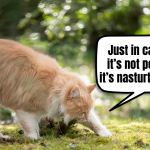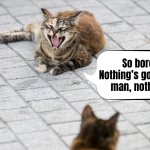Trends in cat manicure have remained unchanged for years: a well-groomed claw sharpened on a scratcher is essential! But even when there are plenty of scratching posts within paw’s reach, and your cat is a true enthusiast of morning workouts on their VIGO, trimming sharp as a pin claws is a topic that no fabCat can ignore. Today, we are exploring the best ways to approach cat manicure so that both the cat and the hooman come out of the “Beautiful Claw at-home salon” unscathed.
To trim or not to trim? Some facts about cat claws
Is trimming a cat’s claws necessary at all? And does every cat require regular pedicure care? It all depends on the cat, their lifestyle, claw condition, and your preferences, fabCat. Sharp claws serve several important functions – they help the cat climb, defend, hunt, and balance. However, for indoor cats, sharp claws can be a problem. And we’re not just talking about the risk of scratching us or our furniture – when a cat hooks their sharp claw into a curtain or chair upholstery, they may have trouble detaching themself, resulting in self-harm. There are also cases where a cat’s claw wraps too tightly under itself, and if not regularly trimmed, it may eventually start digging into the paw pad, causing pain to the cat. Very sharp claws also pose a risk to veterinarians and groomers, to whom cats must occasionally go – when a cat feels threatened, they won’t hesitate to use them.
For typical sofa-loving cats, regular manicure is highly recommended. Trimming the sharpest tip of the claw doesn’t interfere with fulfilling typical cat needs (such as scratching, climbing on scratching posts, or hunting toys) and eliminates unnecessary risks for both the cat and their Carer.
The correct approach is key. How to start the adventure of trimming cat claws?
Trimming cat claws is not a secret art that only a few can master. If you take a moment to understand the structure of a cat’s claw and familiarize your furball with at-home manicure, the whole process can be easy and enjoyable.
To start, a short biology lesson. A cat’s claw is composed of two parts:
- A transparent, keratinous sheath which creates the outer claw that we trim while doing our cat’s manicure (the cat naturally sheds it during scratching),
- The pink quick inside the claw – this is the part you don’t want to cut – it would be extremely painful for the cat.
If you look at a cat’s claw in good light, you will immediately recognize the “live” part of the claw running inside the transparent outer sheath. However, if you’re concerned about cutting the claw too deep, you can start by trimming only the sharpest tip of the claw or follow the rule of cutting a maximum of 1/3 of the claw’s length – usually, this is the dead part, so you avoid harming the quick.
To open your at-home cat manicure salon, you’re going to need good equipment. At this point, we need to warn you in advance – neither regular scissors nor nail clippers designed for human nails will work for trimming cat claws. Such tools are not sharp and hard enough, leading to crushing the outer sheath of the claw and causing it to split. Cat claws should only be trimmed with clippers designed for working on cat claws (those made for dogs will also work, as long as they are not too large and uncomfortable to handle on significantly smaller cat claws).
Last but not least, there’s the matter of familiarizing the cat with the claw trimming process. The earlier you start in the cat’s life, the better, but the foundation is always patience, respect for cat boundaries, and gradual work on pushing those boundaries. A good starting point is getting the cat used to having their paws touched – you can do this daily during petting when the cat is relaxed. Just stroke the cat’s paws, gently press on the pads, give your cat a little foot massage. The idea is for the cat to feel that when you touch their paws, there is no threat – some cats even come to see a massage as pure pleasure! Also, don’t forget to familiarize the cat with the clippers themselves – hold them in your hand, show them to the cat, and even reward them with a treat for sniffing the clippers. Over time, you can progress to stroking the cat’s paw with the clippers (so that they don’t see a threat from them). The more often you work with the cat, the better results you’ll notice.
DON’T DO THIS! How to trim cat claws to make Mr. Cat happy?
The basic rule of cat life is: don’t do anything they force you to do. Cats like to feel that they always have control over the situation, so attempts to forcibly catch the cat and trim their claws often end in a struggle, where your hands and the cat’s pride suffer. So how do you convince the cat that a manicure is something pleasant?
- Don’t act forcefully. Wrestling with a cat that is awake, ready for self-defense, and fleeing at the sight of you with clippers in hand makes no sense. Even if you manage to catch the cat, lay them down safely, and trim their claws, you won’t establish the best relationship between you. And since a cat always operates in life based on their experiences, forcing a manicure will simply make the cat continue to avoid it in the future.
- Don’t be a pushover. Working with cats requires understanding and respecting their needs while being firm. If the cat needs their claws trimmed, you don’t have to tiptoe around it and surrender whenever the cat shows a hint of dissatisfaction. Of course, we don’t want to ruin all the work you’ve done to familiarize the cat with clippers, but at the same time, you can’t allow a situation where avoiding action poses a threat to the cat. Just make sure to choose a good moment for a manicure (e.g., when the cat is sleeping and relaxed), act quickly, and after the job is done, generously reward the cat for their patience. A tasty treat is the best reason for the cat to agree to entrust their claws to a human again in the future.
Finally, a quick reminder: cats with sharp and trimmed claws will always scratch. It’s their nature, their internal need, and no cosmetic procedure can eradicate such a need from a cat. Trimming the sharp tips of the claws, however, allows you to somewhat protect your furniture (and scratching posts) from imminent destruction. And if there are plenty of scratching posts in your home, the cat will gladly focus their energy on them and, with a few exceptions, refrain from testing the durability of upholstery 🙂
What are your tricks, fabCats, for a successful collaboration with your cat during a manicure? We look forward to the best ideas in the comments – we’re eager to try out new suggestions on our team’s cats.




